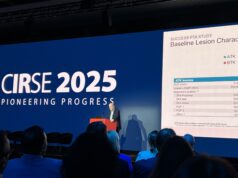 PinnacleHealth CardioVascular Institute has enrolled the first US patient in a trial assessing the safety and effectiveness of a new type of approach for blockages in the leg artery.
PinnacleHealth CardioVascular Institute has enrolled the first US patient in a trial assessing the safety and effectiveness of a new type of approach for blockages in the leg artery.
DISRUPT PAD III is the largest ever multicentre randomised study to exclusively enrol patients with calcified peripheral artery disease. The objective of the trial is to assess the optimal therapy to dilate heavily calcified lesions by comparing the Shockwave Medical Lithoplasty system vs. traditional angioplasty, with a primary goal of achieving less than 30% residual stenosis without the need for stenting. In addition, all patients who do not receive a stent will be treated with a drug-coated balloon. The trial will enrol 334 patients in up to 45 global sites. William Bachinsky, medical director of vascular services at PinnacleHealth CardioVascular Institute, serves locally as principal investigator at PinnacleHealth.
“We are very excited to be the first to treat a US patient in the global study of this cutting edge technology for patients with claudication or pain in the legs due to leg artery blockages,” says Bachinsky. “The Shockwave Medical Lithoplasty device, if proven as a result of this clinical trial, will be a “game changer” in the treatment of patients with peripheral artery disease, allowing for low pressure, controlled expansion of blocked artery and potentially less risk for internal tearing of the artery and need for implanting permanent metal stents.”
Lithotripsy uses high-speed pressure waves to disrupt calcium and has been used for years in treating patients with kidney stones. Lithoplasty technology delivers localised lithotripsy for the treatment of calcified arteries in patients with peripheral artery disease. Built on an angioplasty balloon platform, each catheter incorporates multiple lithotripsy emitters activated with the touch of a button while the integrated balloon is inflated, according to a company release. Once activated, these emitters produce therapeutic sound waves that are inherently tissue-selective, passing through the balloon and soft vascular tissue, preferentially disrupting the calcified plaque by creating a series of micro-fractures. Once the calcium has been disrupted, the vessel can be effectively dilated using low pressures thereby enabling even historically challenging peripheral artery disease patients to be treated effectively and with minimal injury to the vessel.










